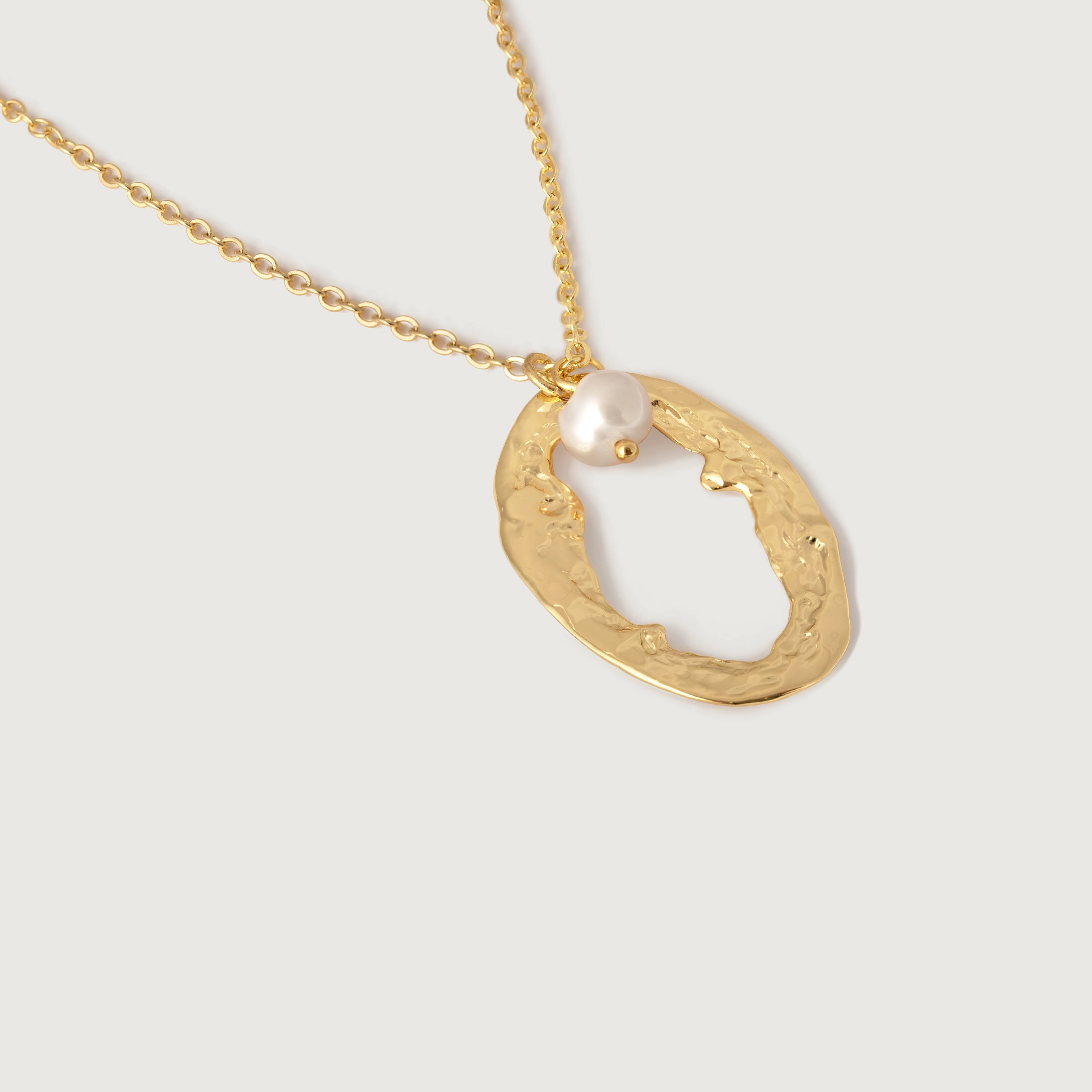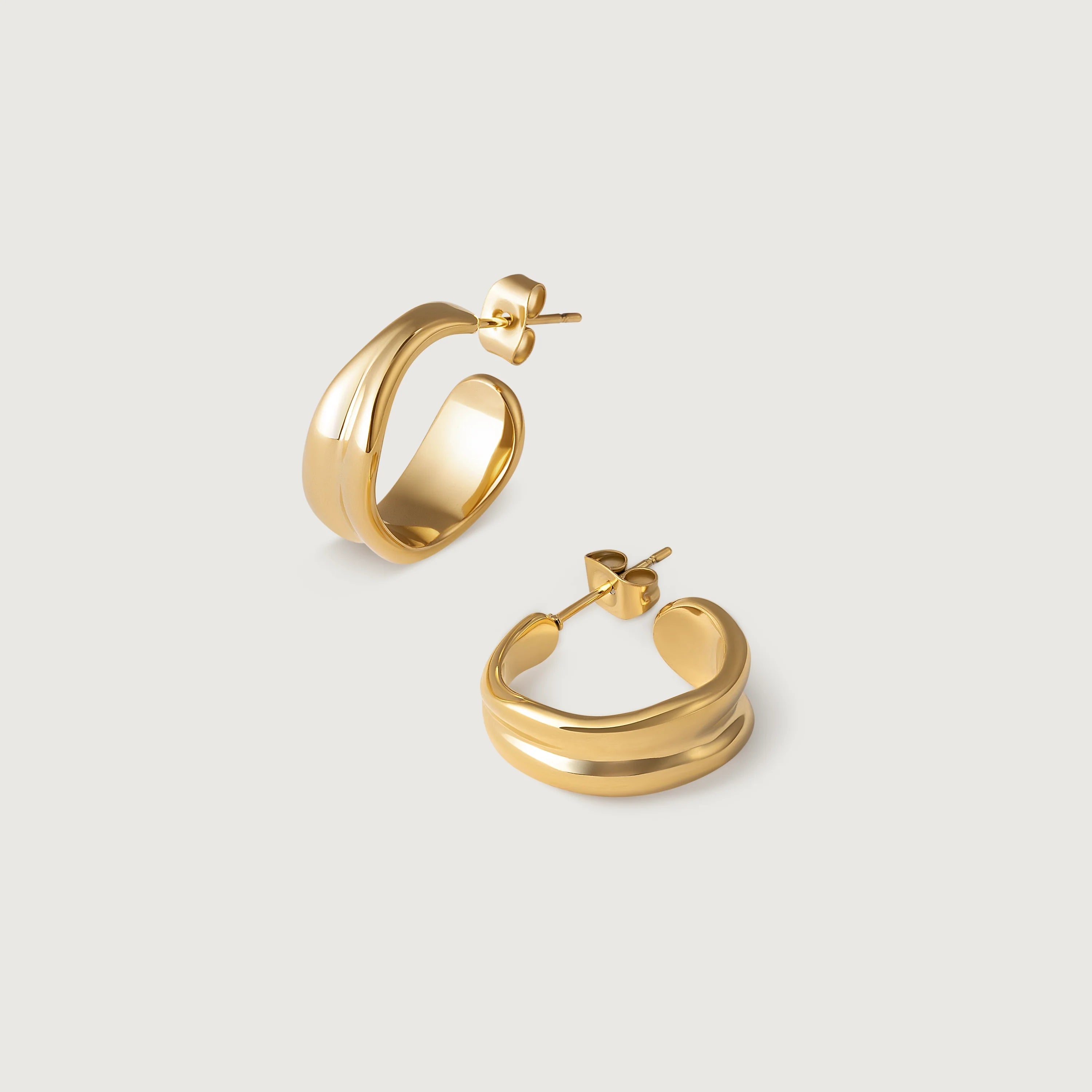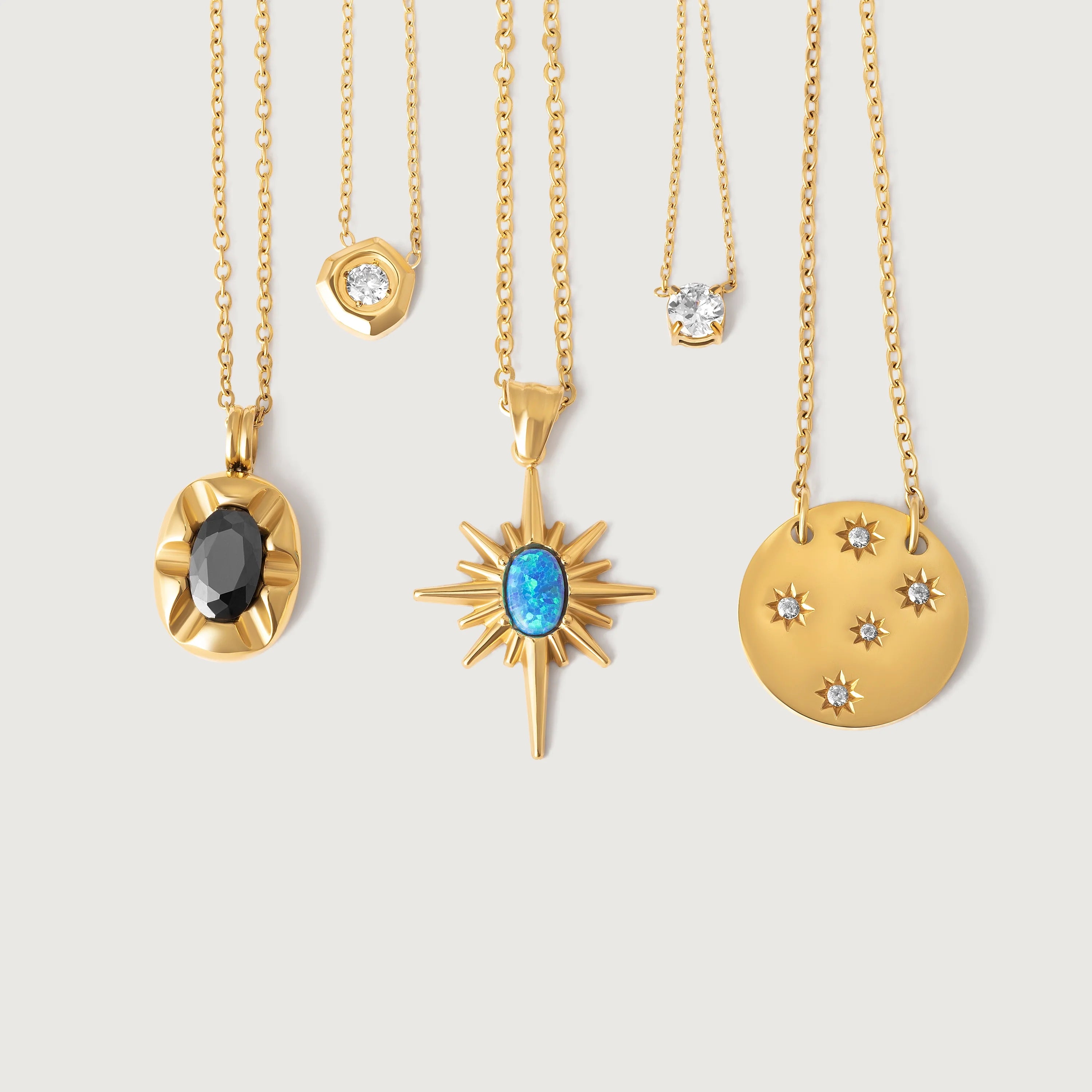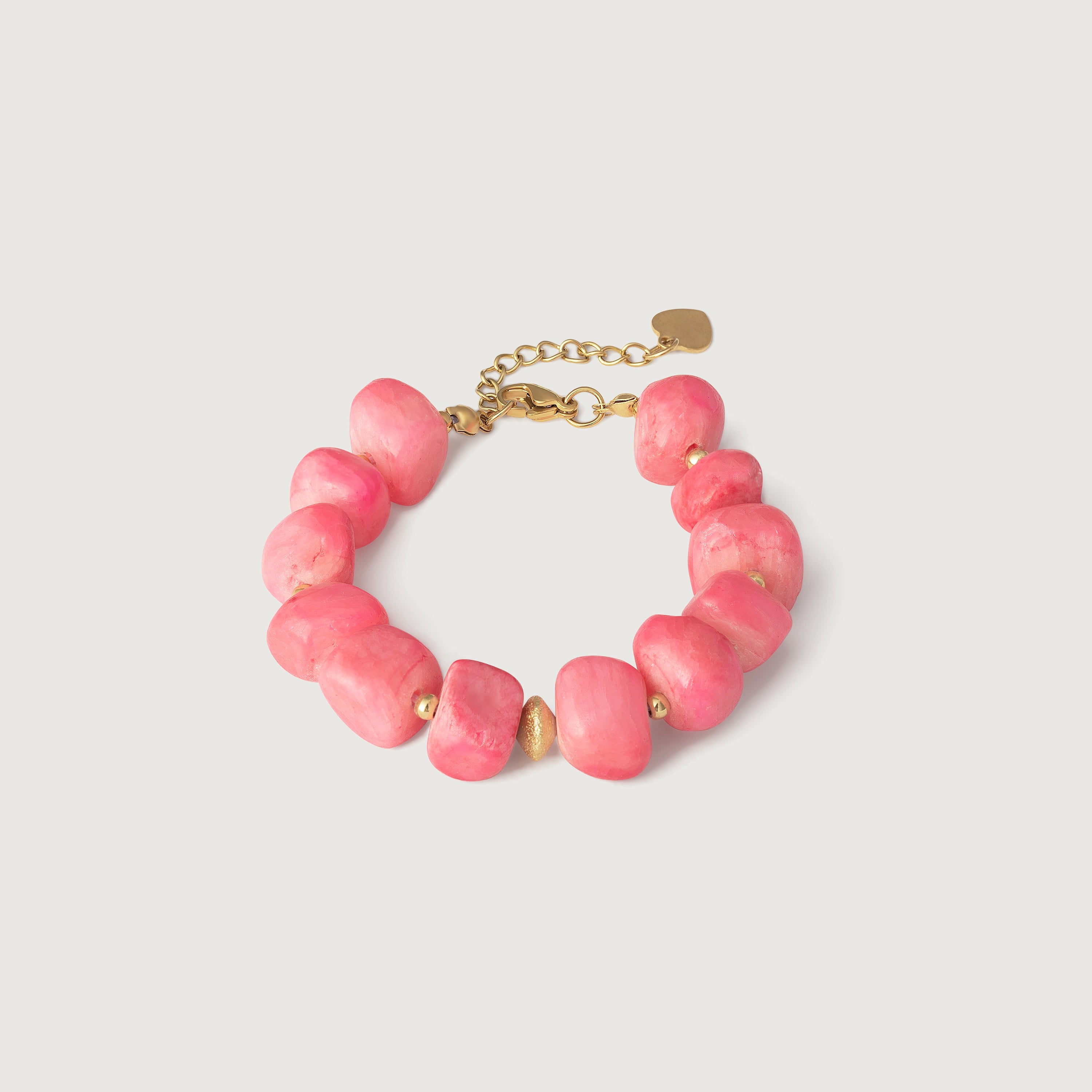Is Gold Plated Jewellery "Waterproof"?
However, it's important to note that advancements in plating technology offer exceptions. For instance, here at Kaleya Studio, we utilise an advanced 18k gold Physical Vapor Deposition (PVD) coating, often applied over a durable 316L stainless steel base. This PVD process creates a much stronger, denser, and more resilient bond compared to traditional electroplating, making our waterproof necklaces, rings, earrings, and bracelets effectively waterproof and capable of handling daily activities like swimming, showering, and sweating.
Truly water-resistant or fully waterproof materials (distinct from coatings) typically include high-karat solid gold, platinum, surgical-grade stainless steel (as a base or on its own), and titanium. These materials have inherent properties that resist water damage far better than traditionally plated base metals.
Consumer Reality Check: Recent research shows that 93% of jewelry owners wear their pieces frequently—daily, weekly, or monthly, with only 7% reserving pieces for special occasions. With UK consumers spending £9.7 billion annually on jewelry and almost two-thirds waiting for discounts before purchasing, understanding water protection is essential for preserving these investments.
Why Water Exposure is Risky for Gold Plating
It's not usually the thin gold layer itself that reacts dramatically with plain water, but rather how water interacts with the entire piece:
It's All About the Base (Metal)
The primary culprit is the base metal beneath the gold. Brass, copper, nickel, and other alloys are much more reactive than gold. Water acts as a catalyst, allowing these metals to interact with air, salts, or chemicals. Even microscopic pores in the plating or areas where wear has begun can allow moisture to reach this reactive base layer.

Triggering Tarnish & Corrosion
When moisture reaches the base metal, it can cause:
- Oxidation: Reacting with oxygen in the air, leading to tarnish (darkening).
- Chemical Reactions: Interacting with chlorine, sulphur (in some soaps), salts, and acids, causing corrosion or discolouration. This tarnish often looks like black, green, or brown spots that can become visible through thin plating or creep out from edges.
Accelerating Plating Wear
While pure water isn't abrasive, the things in water can be. Chlorine is corrosive, salts can be abrasive, and minerals in hard UK tap water can leave deposits. Furthermore, the process of repeatedly wetting and then rubbing jewellery dry increases friction, physically wearing down the delicate gold layer over time.
The Problem with Trapped Moisture
Intricate designs, chain links, clasps, and stone settings can easily trap water. This hidden moisture means prolonged contact between water, air, and the base metal, creating an ideal environment for tarnishing and corrosion long after you thought the piece was dry.
Different Types of Water, Different Levels of Risk
Not all water is created equal when it comes to gold plating:
Plain Tap Water - Low Risk
Quick, accidental splashes are the least damaging, provided you dry the piece immediately and thoroughly. However, repeated exposure is still ill-advised, and the UK's generally hard water can leave mineral deposits. London and South East England's particularly hard water may accelerate buildup.
Showering/Bathing - High Risk
Definitely avoid. This involves prolonged exposure not just to water but also to soaps, shampoos, conditioners, and body washes containing various chemicals and surfactants that can dull, corrode, or tarnish the piece rapidly.
Swimming Pools (Chlorine) - Extremely Damaging
Chlorine is a potent chemical that actively attacks many base metals and can even degrade the gold plating itself. It's one of the fastest ways to ruin plated jewellery.
The Sea & Salt Water - Very Damaging
Salt is highly corrosive to base metals and can also be abrasive, accelerating wear on the plating. This applies whether you're swimming off Brighton Beach, in the Mediterranean, or anywhere salt water is present.
Sweat (Perspiration) - Moderate Risk
Contains salts and can be acidic. Exercising or wearing plated jewellery in hot weather where you sweat significantly can contribute to tarnishing and wear over time. Always remove pieces before a workout!


What Does Water Damage Look Like on Gold Plating?
If your gold-plated piece has suffered water damage, you might observe:
Dullness or Fading
The bright, reflective gold shine diminishes and loses its lustrous appearance
Tarnishing
Noticeable dark spots or patches – often black, greenish (especially with copper bases), or brownish
Visible Base Metal
The plating wears thin or flakes, revealing the different coloured metal underneath, particularly on high-friction areas
Skin Discolouration
Green or black marks may appear on your skin where the jewellery sat, indicating base metal reaction
Oops! What to Do if Your Gold Plated Jewellery Does Get Wet
Accidents happen! If your piece gets wet:
Act Fast
Don't let water sit on the jewelry - time is critical
Rinse (If Necessary)
If exposed to chlorine or salt water, give a quick rinse under cool tap water
Dry Thoroughly
Use a soft, lint-free cloth to gently pat and wipe every surface completely dry
Air Dry Further
Leave on a dry towel for an hour to ensure all hidden moisture evaporates
Critical Drying Areas
Pay special attention to chain links, clasps, and around stone settings where water can easily become trapped. These areas are particularly vulnerable to long-term moisture damage and require thorough attention during the drying process.
Prevention is Key: Keeping Your Plated Jewellery Dry & Beautiful
The best strategy is always prevention:
- Make it a habit: Remove gold-plated jewellery before showering, bathing, swimming, washing dishes, doing household cleaning, or applying lotions, perfumes, hairspray, or hand sanitisers.
- Last On, First Off: Put jewellery on after getting dressed and applying toiletries, and take it off first before undressing or washing up.
- Store Smart: Keep pieces in a dry environment (your bathroom is often too humid, especially in the UK's damp climate). Store them individually in soft pouches or a lined jewellery box to prevent scratching and minimise air exposure.
- Weather Awareness: Be extra cautious during British summer festivals, seaside holidays, and unpredictable weather where sudden exposure to rain might occur.
The True Cost of Water Damage: Repair vs. Replacement
Understanding the financial impact of water damage helps put prevention into perspective. Based on current market data, here's what you can expect:
Industry Insight: The average cost of replating gold jewelry in the UK ranges from £70-£160+ depending on size and complexity, while the cost-of-living pressures mean UK consumers are increasingly selective about jewelry purchases. With almost two-thirds of UK shoppers waiting for discounts before buying, prevention is clearly the economical choice.
Replating Costs (2025 UK Pricing)
- Simple rings: £70-£95 for basic gold replating
- Necklaces/bracelets: £80-£160+ depending on length and intricacy
- Earrings: £65-£120 for standard pairs
- Premium options: Rhodium plating on white gold from £70
- Rush services: Add 50-100% to standard pricing for urgent repairs
When Replating Makes Sense
- Piece has strong sentimental value (over 50% of consumers report significant emotional attachment)
- Original purchase price was over £150
- Only minor wear is visible
- Base metal is high-quality (316L stainless steel, sterling silver)
When Replacement Is Better
- Extensive base metal exposure or corrosion
- Original piece was under £80
- Multiple repairs needed simultaneously
- Piece has poor-quality base metal (brass, copper)
- Current cost-of-living pressures make budget optimization essential
Your Complete Jewelry Care Routine Checklist
Based on consumer behavior research showing that most people wear jewelry daily, here's a practical care routine to maximize your pieces' lifespan:
Last On, First Off
Put jewelry on after getting dressed and applying products; remove first before undressing
Quick Visual Check
Look for signs of wear, loose stones, or discoloration before wearing
Gentle Cleaning
Wipe with soft, dry cloth to remove oils and prevent buildup
Proper Storage Check
Ensure pieces are stored separately in dry environment, not bathroom
Seasonal Care Tips for UK Climate
Your jewelry care needs change with the UK's varied seasons and weather patterns. Here's how to adapt your routine:
Summer Care (High Risk Season)
Challenges: Holiday swimming, increased hand washing, travel to warmer climates, festival season
Actions: Remove pieces before swimming in pools or the sea. Apply sun cream before putting on jewelry. Consider waterproof alternatives for holidays and festivals.
Winter Care (Moderate Risk)
Challenges: Central heating creating dry air, frequent hand sanitiser use, condensation from heated indoor spaces to cold outdoors
Actions: Store with anti-tarnish strips to combat dry air. Allow jewelry to adjust to temperature changes gradually. Clean more frequently due to increased hygiene product use.
Spring/Autumn Care
Challenges: Variable weather requiring frequent jacket changes, increased rainfall, seasonal cleaning activities
Actions: Check storage areas for dampness during wet spells. Perfect time for professional servicing before summer or after holidays. Protect from unpredictable British weather.
Smart Jewelry Wardrobe Strategy for UK Consumers
With almost two-thirds of UK consumers waiting for discounts before purchasing and half buying second-hand jewelry in 2024, building a strategic collection requires careful planning:
Your Three-Tier Jewelry System
Everyday Heroes
Waterproof pieces (PVD-coated or solid precious metals) for daily wear, unpredictable British weather, and worry-free living
Smart Casual
High-quality plated pieces purchased during sales for work, dining out, and planned activities where water exposure is controlled
Special Occasion
Your most precious pieces (including well-maintained vintage or second-hand finds) reserved for important events
Holiday Ready
Durable, worry-free pieces perfect for UK staycations, European city breaks, or tropical getaways without constant vigilance
At Kaleya Studio, our advanced PVD coating technology means you can enjoy beautiful gold jewelry without the constant worry about water exposure. Our pieces are designed for real life – from morning showers to evening swims.
Frequently Asked Questions
Can I shower with gold plated jewelry?
No, avoid showering with traditional gold plated jewelry. Prolonged exposure to water, soap, and shampoo can accelerate plating wear and cause tarnishing of the base metal underneath. However, jewelry with advanced PVD coating technology is designed to withstand daily activities including showering.
How long does gold plating last if exposed to water?
Traditional electroplating can show damage within days of regular water exposure, depending on the base metal and plating thickness. Chlorinated water can cause visible damage in a single exposure. PVD-coated pieces maintain their appearance for years even with daily water contact.
What's the difference between waterproof and water-resistant jewelry?
Water-resistant jewelry can handle occasional splashes but shouldn't be submerged. Waterproof jewelry (like our PVD-coated pieces) can handle swimming, showering, and all daily activities without damage to the finish or base material.
Why does my skin turn green from jewelry and water?
Green staining occurs when copper-based metals (brass, bronze, or copper itself) oxidize due to moisture and react with your skin. This happens faster when the protective gold plating wears thin, allowing water to reach the reactive base metal.
Is it worth replating water-damaged jewelry?
It depends on the piece's value and condition. For pieces worth over £150 or with strong sentimental value, replating (£70-£160) often makes sense. For pieces under £80 with extensive damage, replacement with higher-quality alternatives is usually more economical, especially with current cost-of-living considerations.
How can I tell if my jewelry is truly waterproof?
Look for specific technologies like PVD coating, solid precious metals (14k+ gold, platinum), or surgical-grade stainless steel construction. Traditional electroplating is never waterproof, regardless of marketing claims. Reputable brands will clearly specify their water-resistance technology.
Conclusion: Protect Your Plated Treasures from Water
For most traditionally gold-plated jewellery, getting it wet is a gamble that often doesn't pay off. Water, especially when combined with chemicals like chlorine or salt, primarily attacks the base metal beneath the thin gold layer, leading to unsightly tarnish, corrosion, and accelerated wear.
The data is clear: with UK consumers spending £9.7 billion annually on jewelry yet almost two-thirds waiting for discounts before purchasing, understanding water protection is essential. When replating costs £70-£160+ and may only be temporary depending on the base metal quality, prevention becomes both the practical and economical choice—especially important during current cost-of-living pressures.
Modern jewelry technology has evolved to meet real-world needs. While a quick splash of plain water, dried immediately, might not cause instant ruin for standard plating, consistent exposure or contact with harsh substances will undoubtedly shorten its life and diminish its beauty. The smart approach combines protective care habits with strategic selection—choosing advanced PVD-coated pieces for daily wear while reserving traditional plated pieces for controlled environments.
The Bottom Line: In a market where half of UK consumers are buying second-hand jewelry and 93% wear pieces frequently, investing in durable, water-resistant pieces isn't just about convenience—it's about responsible consumption, long-term value, and peace of mind in unpredictable British weather.
Experience Truly Waterproof Jewelry
Join the growing number of UK consumers who prioritize both style and practicality. Discover Kaleya Studio's collection of advanced PVD-coated jewelry that offers genuine water resistance—designed for the 93% of jewelry lovers who wear their pieces daily. Perfect for unpredictable British weather, from Lake District walks to Mediterranean holidays. No more removing jewelry for showers, swimming, or sudden downpours.



